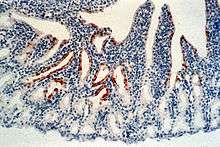Avulavirinae
Avulavirinae is a subfamily of viruses in the family Paramyxoviridae.[1][2][3] Members of the subfamily are collectively known as avulaviruses. All members of the subfamily primarily infect birds. Avulavirinae was previously recognized as the genus Avulavirus before being elevated to a subfamily. The term avula comes from "avian rubula", distinguishing it from rubulaviruses of the subfamily Rubulavirinae due to avulaviruses only infecting birds and translating protein V from an edited RNA transcript. The most notable avulavirus is the Newcastle disease virus, a strain of Avian orthoavulavirus 1.
| Avulavirinae | |
|---|---|
 | |
| Avian orthoavulavirus 1 (stained in brown) in the conjunctiva of a chicken | |
| Virus classification | |
| (unranked): | Virus |
| Realm: | Riboviria |
| Kingdom: | Orthornavirae |
| Phylum: | Negarnaviricota |
| Class: | Monjiviricetes |
| Order: | Mononegavirales |
| Family: | Paramyxoviridae |
| Subfamily: | Avulavirinae |
| Genera | |
| |
Taxonomy
Subfamily: Avulavirinae[4]
- Genus: Metaavulavirus, which contains ten species, numbered 2, 5, 6, 7, 8, 10, 11, 14, 15, and 20
- Genus: Orthoavulavirus, which contains nine species, numbered 1, 9, 12, 13, 16, 17, 18, 19, and 21
- Genus: Paraavulavirus, which contains two species, numbered 3 and 4
Prior to the subfamily being elevated from genus, members of the genus were known as Avian paramyxovirus, then later as Avian avulavirus, followed by numbers 1 to 19, which designated the species number. These numbers, along with the 20th and 21st members of the subfamily, are now dispersed across the three genera. Each species is named Avian followed by the name of its genus and its individual number, for example Avian orthoavulavirus 1.[4]
Characteristics
Avulaviruses have a hemagglutinin-neuraminidase attachment protein and do not produce a non-structural protein C. Avulaviruses can be separated into distinct serotypes using hemagglutination assay and neuraminidase assay. All avulaviruses hemagglutinate chicken RBCs except for avian metaavulavirus 5 which does not hemagglutinate RBCs from any species. Avian metaavulavirus 6 is unique to the presence of the SH gene between the F and HN genes. Avian metaavulavirus 11 has the longest genome among the APMVs.[5]
References
- Balkema-Buschmann, Anne; et al. (6 June 2018). "Re-organization of the family Paramyxoviridae" (docx). International Committee on Taxonomy of Viruses. Retrieved 23 September 2019.
- Rima, B; Balkema-Buschmann, A; Dundon, WG; Duprex, P; Easton, A; Fouchier, R; Kurath, G; Lamb, R; Lee, B; Rota, P; Wang, L; ICTV Report Consortium (December 2019). "ICTV Virus Taxonomy Profile: Paramyxoviridae". The Journal of General Virology. 100 (12): 1593–1594. doi:10.1099/jgv.0.001328. PMID 31609197.
- "ICTV Report Paramyxoviridae".
- "Virus Taxonomy: 2019 Release". talk.ictvonline.org. International Committee on Taxonomy of Viruses. Retrieved 7 May 2020.
- Gogoi, P; Ganar, K; Kumar, S (2015). "Avian Paramyxovirus: A Brief Review". Transboundary and Emerging Diseases. 64 (1): 53–67. doi:10.1111/tbed.12355. PMID 25924108.